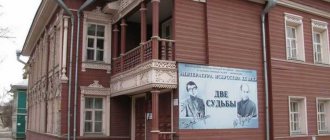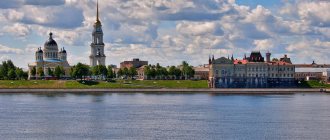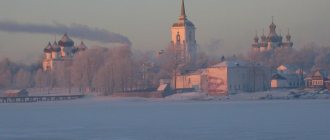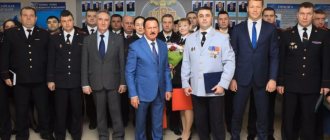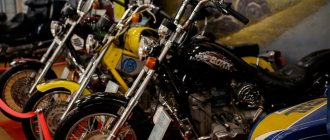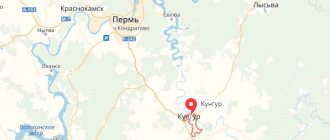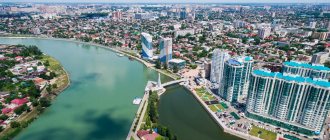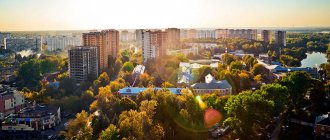Kaliningrad, Korolev, the space capital of Russia, the science city - this is all about the city in which I live.
Since 2014, I have been living in the city of Korolev, in the green Tekstilshchik microdistrict, in the Committee Forest. Not far from the house is the Podlipki-Dachnye railway station. Near the house is Bolshevskoe Highway, along which bus route No. 499 runs, connecting Korolev with the VDNKh metro station, which provides convenient transport accessibility to the capital.
I like life in Korolev, where after the hustle and bustle of Moscow, where I work and therefore spend most of the day there, this is where I relax. Our house is low-rise, so there is no noise or a lot of people in the yard. It’s cool when at night through an open window you hear not the rustling of tires and the roar of motorcycles, but only the noise of trees and bird trills. This is especially great in the early summer when the nightingales sing.
What to see in the city of Korolev in 1 day
The vast majority of people associate Korolev with science and space. Tourists come to the science city to get acquainted with the achievements of Soviet and Russian scientists. The city is also visited by fans of Marina Tsvetaeva, because it is here that one of the main museums in memory of the great poetess is located.
Mission Control Center
- Address: Pionerskaya st., 4, bldg. 1.
Korolev is the citadel of the Russian space industry. The famous MCC has been monitoring the movements and actions of spacecraft since the 60s. These days, the center hosts excursions where visitors can see with their own eyes the work of specialists and watch a live video broadcast from space. When visiting the MCC, you must turn off your mobile phones.
RSC Energia Museum
- Address: st. Lenina, 4A.
The modern Rocket and Space Corporation (RSC) is a direct descendant of the famous design bureau founded by Sergei Korolev. The corporation operates a museum dedicated to the history of space exploration. It contains the very first samples of spacesuits, artificial satellites, ballistic missiles and the real Vostok-2 spacecraft. In a separate room, experts reproduced the furnishings of Korolev’s office.
House-Museum of M.I. Tsvetaeva
- Address: st. Marina Tsvetaeva, 15.
Modern Korolev consists of several settlements, one of the oldest and most significant among them is the village of Bolshevo. Here, under the tall pines, a green wooden house with large windows was lost. The small mansion is the place where the famous poetess Marina Tsvetaeva lived in 1939 after returning from France.
Marina Ivanovna spent less than six months in the village, but the events that occurred during this period of time had a terrible impact on the future life of the long-suffering woman. After 17 years of emigration and life in poverty, Tsvetaeva was forced to return to her homeland, which greeted the poetess harshly and only prepared new challenges for her. After the arrest of her husband and daughter, Marina Ivanovna was left alone with her youngest son and had difficulty surviving without the help of family and friends.
The Tsvetaeva Museum began operating in 1992. The house contains objects that are related to the life and work of the famous poetess. The rooms have preserved original furniture and dishes that belonged to Marina Ivanovna. Near the entrance to the house, guests are greeted by a stone sculpture of Tsvetaeva.
Climate
The climate of the city of Korolev, as well as the entire Moscow region, is temperate continental, slightly different from the climate of Moscow. In winter it is somewhat colder here, and in summer (June is warmer here than August) it is not as hot and stuffy as in the Russian capital, and there is slightly less precipitation. The coldest month, unlike the regional center, is January, and March here is colder than November. Thaws are also common in December. .
| Climate of Korolev (norm 1836—2016) | |||||||||||||
| Index | Jan. | Feb. | March | Apr. | May | June | July | Aug. | Sep. | Oct. | Nov. | Dec. | Year |
| Average maximum, °C | −6,4 | −4,8 | 0,8 | 10,3 | 17,9 | 21,9 | 23,4 | 21,4 | 15,2 | 7,8 | 0,4 | −3,7 | 9,1 |
| Average temperature, °C | −9,4 | −8,3 | −2,9 | 5,9 | 12,6 | 16,7 | 18,5 | 16,6 | 11,1 | 4,9 | −1,8 | −6,3 | 5,4 |
| Average minimum, °C | −12,4 | −11,7 | −6,3 | 1,5 | 7,3 | 11,6 | 13,6 | 11,9 | 7 | 2 | −4 | −8,9 | 1,8 |
| Precipitation rate, mm | 41 | 34 | 32 | 42 | 50 | 75 | 90 | 74 | 62 | 60 | 56 | 52 | 668 |
| Source: | |||||||||||||
Where to go for a walk in Korolev with children and adults
In addition to the “cosmic” attractions, tourists should visit the wonderful natural spots and cultural sites of the city.
"Elk Island"
- Coordinates on the map: 55.858333, 37.814444.
The urban district of Korolev borders on one of the first national parks in Russia. The reserve received its unusual name due to the large population of moose living in the local forests. In addition to the horned beauties, the park is home to foxes, muskrats, beavers, and various species of birds. Museums are open on the territory of the reserve, exciting excursions and horseback riding are held.
Park named after Marina Tsvetaeva
- Address: corner of Uritsky and Marina Tsvetaeva streets.
House-Museum of M.I. Tsvetaeva is located in a picturesque corner of the Bolshevo microdistrict. In 1939, the poetess collected brushwood here to light the stove, heat the house and cook food. Since then the place has changed. A semi-wild plot of land has turned into a well-equipped Literary Park with neat paths, benches for relaxation and bright flower beds. Large stone boulders with bronze tablets with poems by Marina Tsvetaeva are placed everywhere.
Square of Space Conquerors
- Address: corner of Oktyabrskaya and Kalinina streets.
The square near the Drama Theater is a great place for walking and relaxing. The area was landscaped in 2002, the paths are tiled, and bright flowers grow everywhere. Playgrounds have been built for children. In the center of the square stands one of the best sculptural compositions of the city - a monument to S. Korolev and Yu. Gagarin.
Central Palace of Culture
- Address: st. Tereshkova, 1.
Construction of the Palace of Culture began in 1958 on the initiative of Sergei Korolev. The scientist personally laid the first stone in the foundation of the future structure. The work lasted 6 years and in 1964 the Palace opened its doors to residents of the science city. Important cultural events, folk festivals, holiday concerts and even sporting competitions take place in the building itself and in the square next to it.
Geography
The city is located northeast of Moscow, 23 km from the center and 6-7 km from the Moscow Ring Road along the Yaroslavskoye Highway.
Yaroslavskoe Highway is the western border of Korolev (excluding the Zalineiny District). The Losiny Ostrov National Park adjoins the city to the south, and holiday villages to the north and east. The Klyazma River flows through the city, as well as many small rivers (in the part of Losiny Ostrov). Forests within the city cover an area of 3,800 hectares. Also within the city limits there is part of the Yauzsky Wetland Complex tract. The area occupied by the city is 55.44 km². The area of the urban district is 55.47 km².
A new medicine for the treatment of coronavirus. Molnupiravir is already registered in the UK. Go to article
| Distance from Korolev to major cities (in a straight line)/(by road) | |||||||||
| Dmitrov ~51 km / 68 km. Dubna ~122 km / 125 km. Konakovo ~138 km / 150 km. Tver ~160 km / 165 km. St. Petersburg ~691 km / 700 km. | Pushkino ~3 km / 4 km. Sergiev Posad ~42 km / 47 km. Yaroslavl ~205 km / 221 km. Vologda ~378 km / 427. Arkhangelsk ~970 km / 1200 km. | Ivanteevka ~2 km / 3 km. Fryazino ~7 km / 15 km. Alexandrov ~86 km / 100 km. Kostroma ~272 km / 310 km. Sharya ~532 km / 630 km. Kirov ~761 km / 936 km. Perm ~1139 km / 1500 km. Ekaterinburg ~1010 km / 1430 km. Urai ~1651 km / 2300 km. | |||||||
| Lobnya ~22 km / 35 km. Khimki ~24 km / 29 km. Volokolamsk ~122 km / 140 km. Rzhev ~224 km / 250 km. Pskov ~618 km / 750 km. Riga ~850 km / 970 km. | Shchelkovo ~4 km / 6 km. Noginsk ~37 km / 42 km. Vladimir ~157 km / 167 km. Nizhny Novgorod ~ 388 km / 410 km. Cheboksary ~575 km / 640 km. Kazan ~700 km / 790 km. Naberezhnye Chelny ~900 km / 1100 km. Ufa ~1147 km / 1300 km. Chelyabinsk ~1480 km / 1700 km. | ||||||||
| Mytishchi ~2 km / 3 km. Moscow ~3 km / 5 km. Obninsk ~140 km / 150 km. Kaluga ~182 km / 215 km. Bryansk ~367 km / 420 km. Kyiv ~770 km / 880 km. Bucharest ~1522 km / 1900 km. | Lyubertsy ~23 km / 36 km. Podolsk ~51 km / 66 km. Serpukhov ~124 km / 132 km. Tula ~191 km / 210 km. Voronezh ~470 km / 530 km. Volgograd ~910 km / 990 km. Krasnodar ~1211 km / 1400 km. | Balashikha ~7 km / 18 km. . Zhukovsky ~36 km / 52 km. Yegoryevsk ~90 km / 120 km. Kolomna ~110 km / 135 km. Ryazan ~175 km / 210 km. Boot ~285 km / 345 km. Tambov ~395 km / 495 km. Astrakhan ~1270 km / 1400 km. Baku ~1942 km / 2400 km. | |||||||
Royal museums and theaters
Korolev is not only a citadel of science, but also a cultural center. The city has museums and theaters for people of all ages.
Royal History Museum
- Address: st. Tereshkova, 1.
The main Korolev Museum was formed in 2005 and united several old museums: space, history and local history. The opening was timed to coincide with the 60th anniversary of the Great Victory. The exhibitions cover the history of the space and defense industry in Korolev, and also demonstrate the life of the inhabitants of the Russian Empire and the Soviet Union. The museum features the largest collection of military and civilian vehicles.
Kostino Estate Museum
- Address: st. Ilyich, 1A.
At different times, interesting historical figures lived in the estate in the village of Kostino: the Dolgoruky princes and the revolutionary Vladimir Lenin. The modern building was built at the beginning of the 20th century; in 1922, the “Father of the Revolution” lived in it. At that time, Vladimir Ilyich was already seriously ill and soon moved to Moscow, where he died two years later.
In 1924, troubled teenagers, orphans and street children began to be brought to Kostino. The estate became a kind of labor correctional colony for juvenile delinquents. In 1939, the estate was transformed into a museum in memory of Lenin. Over time, the profile of the museum expanded to include local history and art exhibitions.
House-Museum of S.N. Durylina
- Address: Svobodnaya st., 12, Bolshevo microdistrict.
Sergei Nikolaevich Durylin is one of the most famous residents of Korolev, a writer and scientist who studied issues of philosophy and theology. In 1936, the writer settled with his wife in a small log house with an unusual semicircular projection.
Famous artists and writers often came to see the theologian, including the famous painter M. Nesterov. Here Sergei Nikolaevich ended his earthly journey.
In 1993, the house was transformed into a museum in memory of the poet; many personal belongings of the writer were preserved inside, such as furniture, books, photographs, as well as a rich collection of paintings by Soviet and Russian artists and ancient icons.
House-Museum of O.M. Kuvaeva
- Address: Bolshevskoye sh., 31.
Oleg Mikhailovich Kuvaev is an outstanding Soviet geologist, writer, screenwriter, who became famous thanks to his stories and essays about geological expeditions. The author’s most important work is the novel “Territory,” which has been reprinted dozens of times, translated into many languages and filmed twice in 1978 and 2014.
In the 60s, Kuvaev decided to leave geology and devote himself entirely to writing prose. In 1966, Oleg Mikhailovich settled in Kaliningrad near Moscow and lived there until his death in 1975. The writer’s sister and nephew founded a museum in the house in memory of the famous relative. The house contains the geologist’s personal belongings and various editions of his works.
Drama Theater
- Address: st. Tereshkova, 1.
Many residents of Korolev are not only intellectually, but also creatively gifted people who value theatrical art. The first performances in Podlipki began to take place back in 1924. Despite repeated changes in the names of the village and city, the theater remained the “Comedy and Drama Theater in Podlipki” until 2005.
For many years the repertoire consisted mainly of folk works. In 2005, the post of artistic director was taken by Andrei Kryuchkov, who radically changed both the direction of the theater and its cast.
Theater for Young Spectators
- Address: Kaliningradskaya st., 12.
Residents of Korolev care about cultural leisure not only for adults, but also for children. In 1994, the Theater for Young Spectators opened in the city. The first amateur performances took place back in 1976 at the children's club of the local House of Culture.
In 1983, the amateur theater received the status of “folk”, and 11 years later it became professional. In 2002, the Youth Theater moved to a separate building. Little queens not only watch fairy-tale performances, but also learn acting skills and participate in productions.
Read in the topic: The best attractions of the Moscow region
Internal division
Central part of the city
Korolev is divided into several historical districts and parts, often named after former settlements absorbed by the city during its development:
- Central part - Podlipki, New Podlipki, Zavokzalny, Zalineiny, 45th quarter, Kostino, Samarovka.
- Bolshevo microdistrict - Bolshevo, Burkovo, Committee Forest, Valentinovka.
- Microdistrict Oboldino
- Microdistrict Pervomaisky - Factory 1 May, New Gorki, Lesnye Gorki, Starye Gorki, Goznak, Komarovka, Maksimkovo.
- Tekstilshchik microdistrict - Advanced textile worker, Kalinina village, 43rd quarter.
- Microdistrict Torfopredpriyatie - Torfopredpriyatiye, 12th switch, Pogonny.
- Microdistrict Yubileiny - 1st town, 2nd town, 3rd town, 4th town.
Architectural monuments Queen
Korolev is a young city, but several architectural monuments of the 19th century have been preserved on its territory, as well as interesting examples of Soviet architectural thought.
Lapino-Spasskoye Estate
- Address: microdistrict Pervomaisky, st. Sovetskaya, 9.
The estate in the village of Lapino appeared in the 19th century thanks to the local manufacturer Panteleev. In subsequent years, the estate changed several owners, and the last owner of the mansion and adjacent buildings was entrepreneur A.N. Craft. After the change of government, the estate turned into socialist property and served the working people.
Several buildings have survived to this day, among which the three-story manor house and a small one-story outbuilding stand out. The main house housed a kindergarten; a music school still operates in the outbuilding. The mansion requires major renovations; the building is currently abandoned.
Culture and Leisure Center
- Address: Sovetskaya st., 71, Pervomaisky microdistrict.
The building of the cultural center in Bolshevo is an architectural monument of the 19th century. Initially, the simple brick building belonged to a dyeing factory and only in Soviet times became the main cultural attraction of the village.
For a long time, the youth club “Fakel” worked here; club members organized the first drama club in the settlement. Today the center accommodates more than a dozen creative groups, children's clubs and interest clubs.
First house of MZhK
- Address: ave. Koroleva, 18/6.
The youth residential complex is a unique example of Soviet architecture. From 1971 to 1991, massive construction projects took place throughout the Union, and houses were erected for young families. At the beginning of the all-Union experiment, young builders from all over the country came to Kaliningrad, the future Korolev.
It was here that the very first multi-storey building of the complex was built. The façade of the building, like a beehive, consists entirely of cell-balconies. Some of the apartments are still occupied by the families of the original residents.
Population
| Population | ||||||||||
| 1931 | 1939 | 1959 | 1962 | 1967 | 1970 | 1975 | 1976 | 1979 | 1982 | 1985 |
| 2800 | ↗44 000 | ↘41 427 | ↗76 000 | ↗96 000 | ↗105 945 | ↗107 000 | →107 000 | ↗133 470 | ↗138 000 | ↘125 000 |
| 1986 | 1987 | 1989 | 1990 | 1991 | 1992 | 1993 | 1994 | 1995 | 1996 | 1997 |
| ↘124 000 | ↗146 000 | ↗159 363 | ↘137 000 | ↘136 000 | →136 000 | →136 000 | ↘135 000 | →135 000 | ↘134 000 | →134 000 |
| 1998 | 1999 | 2000 | 2001 | 2002 | 2003 | 2004 | 2005 | 2006 | 2007 | 2008 |
| →134 000 | ↘133 200 | ↘132 400 | ↗132 900 | ↗143 000 | ↘142 600 | ↗170 700 | ↗171 600 | ↗172 800 | ↗173 600 | ↗174 600 |
| 2009 | 2010 | 2011 | 2012 | 2013 | 2014 | 2015 | 2016 | 2017 | ||
| ↗175 360 | ↗183 402 | ↘183 398 | ↗185 643 | ↗187 284 | ↗187 811 | ↗220 947 | ↗221 129 | ↗221 797 | ||
As of January 1, 2021, the city ranked 93rd out of 1,112 cities in the Russian Federation in terms of population
The city of Yubileiny was “interspersed” within the territory of the city of Korolev (it was previously under its administrative subordination); the total population of both cities, according to the 2010 census, exceeded 220 thousand people. On June 2, 2014, the former city of Yubileiny officially became part of the city of Korolev.
After the absorption of Yubileiny, Korolev became the third city in the Moscow region in terms of population after Balashikha (450,771) and Khimki (244,668).
Which Queen Temples are worth visiting?
Many residents of the science city are believers; therefore, in the territory of the urban district you can find many active Orthodox churches.
Church of the Life-Giving Trinity
- Address: st. Gorky, 77.
The delightful Trinity Cathedral is the largest church in the city. The construction of the red brick building began in 2006; three years before that, the wooden Church of the Life-Giving Trinity was built. In 2007, the construction of a two-story, five-domed cathedral and a multi-tiered bell tower was completed. The central entrance was decorated with a huge image of the Old Testament Trinity.
The lower church of the cathedral has two chapels, the main chapel is consecrated in honor of the Pochaev Icon of the Mother of God, the small chapel is in honor of the Nativity of John the Baptist and St. Spyridon of Trimythous. The church hosts classes for Sunday school students, and also operates a library of church literature.
Church of Saints Cosmas and Damian
- Address: Stationnaya str., 43, Bolshevo microdistrict.
The Church of the Unmercenary Saints Cosmas and Damian is one of the oldest in the village of Bolshevo and in the whole of Korolev. The first mention of the temple dates back to the 16th century, but the original building did not survive. The modern stone structure was built at the end of the 18th century with donations from Prince Pyotr Ivanovich Odoevsky, a famous writer and philanthropist.
The building changed its external and internal appearance more than once; the most serious changes occurred during the Soviet period, when the temple was captured by the Bolsheviks and partially destroyed. Near the church walls there are several graves in which past abbots and clergy of the temple are buried.
Church of the Transfiguration
- Address: Stationnaya str., 45A, Bolshevo microdistrict.
A few meters from the temple of Cosmas and Damian there is another interesting parish. From the outside, the bright yellow church looks like an ordinary multi-story building or city institution. Only the semicircular apse on the eastern side and the gilded domes with crosses indicate that the building belongs to religion. The three floors of the structure housed the Church of the Transfiguration of the Lord, a Sunday school, a library and utility rooms.
The unusual church was erected at the beginning of the 19th century at the expense of Prince P.I. Odoevsky. During Soviet times, the Bolshevo administration worked in the building. After the collapse of the USSR, the building was returned to the Church and re-consecrated. Currently, services are held in the temple and lessons of the Law of God are held. Restoration work continues to this day.
Church of the Nativity of the Blessed Virgin Mary
- Address: Kaliningradskaya st., 1.
The bright Nativity Church is one of the main decorations of the village of Kostino. The blue and white brick building was erected in 1999 on the site of a wooden church from the 17th century. The ancient structure was destroyed by the Bolsheviks at the beginning of the 20th century, at which time the Smolensk Icon of the Mother of God, which had been kept in the church for many years and was revered as miraculous, disappeared without a trace. The church is open to pilgrims and tourists.
Chapel of St. Alexander Nevsky
- Address: st. Tsiolkovsky, 26.
A tall chapel of an unusual shape is located near the Walk of Fame and is part of the memorial complex. The beautiful building looks more like a bell tower; in the upper tier there is a belfry. The black roof sets off the white walls with beautiful bas-reliefs.
The chapel was built in 1999 and consecrated in honor of the blessed Prince Alexander Nevsky, the patron saint of the army. During services in the church, all those who fell during the Great Patriotic War are remembered.
Korolev urban district
During the implementation of the Federal Law “On the general principles of organizing local self-government in the Russian Federation” (No. 131-FZ of October 6, 2003, entered into force on January 1, 2006), municipalities were created in the Moscow region. In 2005, the municipal formation “city of Korolev, Moscow region” was transformed into the urban district of Korolev, which included 1 settlement - the city of Korolev.
Geographical data
The area of the urban district is 5,547 hectares. Initially, in 2005, the area was set at 5,195 hectares, which was subsequently clarified. At the same time, the area of the city proper within its traditional boundaries was 3,882 hectares. The boundaries of the city and urban district coincide.
The municipality borders:
- with the urban district of Ivanteevka (in the northeast),
- with the urban settlement of Shchelkovo, Shchelkovo municipal district (in the east),
- with the urban settlement of Zagoryansky, Shchelkovsky municipal district (in the east),
- with the urban district of Balashikha (in the south),
- with the urban settlement of Mytishchi, Mytishchi municipal district (in the west),
- with the rural settlement of Tarasovskoye, Pushkin municipal district (in the north),
Authorities
The local government authorities of the Korolev urban district are:
- The Council of Deputies of the city of Korolev, Moscow Region
is an elected representative body of local government. It consists of 25 deputies elected for a period of 5 years - The head of the city of Korolev, Moscow Region,
is a person who is elected by deputies of the Council of Deputies from among its members for the term of office of the Council of Deputies. He also exercises the powers of the Chairman of the Council of Deputies. - The administration of the city of Korolev, Moscow region
, is the executive and administrative body of local government. The head of the administration is appointed by contract.
From March 1996 to August 2009, the head of the city was Alexander Morozenko, who was temporarily removed from office by decision of the Korolyovsky City Court. Since 2009, Andrei Borisovich Kapustyan has acted as the mayor of the city.
By the decision of the Council of Deputies of the city of Korolev dated July 27, 2011, the powers of A. F. Morozenko were terminated early. V. A. Minakov was elected head of the city
.4 April 2014 Valery Minakov resigned. Valery Myasoedov was appointed acting head of the city.
On September 14, 2014, the candidate from the United Russia party, Alexander Khodyrev, was elected head of Korolev.
Main monuments in Korolev
The kings do not skimp on monuments for important historical figures and prominent citizens.
To the creators of space technology
- Address: Yaroslavskoe highway.
At the entrance to the city there is its main symbol - the R-2 ballistic missile, which was invented by Sergei Korolev in 1948. A stone copy of the rocket on the launcher was built in 1997 - for the 40th anniversary of the launch of the first artificial satellite. An unusual sign indicates to drivers that they are entering a defense and space industry city.
Monument to S.P. Queen
- Address: ave. Queen.
A city with a human surname could not do without a monument to the one in whose honor it was named. A huge bronze figure of the academician on a granite pedestal rises on the central city avenue, which also bears the name of the great Soviet scientist.
Korolev is depicted in motion, which perfectly characterizes the designer: Sergei Petrovich constantly worked, never stopped on his laurels and always moved forward in the literal and figurative sense of the word.
The monument was erected in 1988, 22 years after the early death of the scientist. Korolev’s students and colleagues, people who knew him personally, came from all over the country to attend the grand opening. Today, couples in love meet and families walk near the monument.
Monument "Korolev and Gagarin"
- Address: Space Conquerors Square.
In the “Conquerors of Space” park there is another monument to Academician Korolev. The great designer sits on a bench with the world's first cosmonaut Yu.A. Gagarin. The space pioneers are talking about something, perhaps discussing the first flight. The sculptural composition stands in the center of a round stone pedestal, on which local residents place flowers every year.
Memorial of Military Glory
- Address: Victory Square.
The Queen Memorial Complex consists of several monuments. The main monument is three stone figures on a high pedestal. A woman is depicted in the center of the composition, with male soldiers on either side of her. The female figure simultaneously symbolizes the home front workers, who shouldered heavy male labor, and the peaceful life for which the soldiers fought.
At the foot of the monument are carved the names of local residents who died on the battlefields. A little to the side stands a massive granite star with the names of Kaliningrad residents awarded the title of Hero of the Soviet Union. In 2000, the memorial complex was replenished with a monument to those killed in local wars.
Story
In the twelfth century, several villages of Slavic tribes were located on the territory of the settlement, scattered along the banks of the Klyazma River. It is believed that in this area there was an ancient trade route connecting the principalities of Moscow and Vladimir-Suzdal. At the beginning of the eighteenth century, one of the first industrial enterprises in Russia was launched in this place - a manufactory producing linen and cloth. In 1918, the Ordnance Plant from Petrograd was moved to the territory of the Podlipki holiday village.
Podlipki appeared as a holiday village at the end of the century before last, after which the name changed three more times: in the twenty-eighth year of the last century - the village of Kalininsky, in the thirty-eighth year - the city of Kaliningrad. And in 1996, in honor of the general designer of rocket and space systems S.P. Korolev, it was renamed the city of Korolev. Its attractions are closely related to the history of the name.
The structure of Kaliningrad includes two more settlements - Bolshevo and Kostino. They have an interesting history, which has become an integral part of the chronicle of Kaliningrad-Koroleva. For more than three hundred years, the Bolshevo land had the glory of an ancient center of weaving production. Even in the times of Peter the Great, canvas from Bolshevo was used to equip the nascent Russian fleet.
Kostino became known in the country and abroad for the presence of a labor commune for street children, which was organized in the twenty-fourth year of the twentieth century at the suggestion of “Iron” Felix.
Now let's move on to the main thing. Let's begin to describe the sights of Korolev.
Transport
Main article: Korolev Transport
Electric train ED4M-0226 on the square. Bolshevo (Fryazino direction), 2008
The railway connects Korolev with Moscow (Yaroslavsky station), cities and towns of Shchelkovsky and Noginsky districts, Mytishchi, Ivanteevka, Fryazino. The following stations and platforms are located within the city:
- Podlipki-Dachnye station
- Bolshevo station, consisting of two platforms: Moninsky direction and Fryazinsky direction.
- platform Valentinovka (on the Moninsky direction)
- platform Fabrika 1 May (in the Fryazino direction)
The interval of electric trains during rush hour at the station. Podlipki-Dachnye, Bolshevo - 7-10 minutes, outside rush hour - up to 30 minutes. The interval on the platforms in the Fryazino direction is 20-40 minutes. On weekdays there is the so-called. “technological window” (from approximately 11 a.m. to 1 p.m.), during which electric trains do not operate.
On September 5, 2008, the Sputnik high-speed electric train was launched at intervals of 30 minutes during peak hours.
Bus service
Bus service to the population is provided by two carriers - State Unitary Enterprise MO "Mostransavto" (Korolevskoe PATP) and LLC "Avtotravel". The following routes operate in the city:
Higer bus route 392 near VDNH metro station
- 1 (Silikatnaya St. - Bolshevo Station - Podlipki Station - Silikatnaya St.)
- 2 (Silikatnaya St. - Podlipki Station - Bolshevo Station - Silikatnaya St.)
- 3 (Silikatnaya St. - Podlipki Station
- 4 (Silikatnaya street - Bolshevo station - Podlipki station - Market on Yauza)
- 5 (Michurina St. - Podlipki Station)
- 6 (st. Bolshevo - Michurina st. - Oboldino)
- 7 (Bolshevo station - Michurina street - Peat enterprise)
- 7 (Bolshevo station - Michurina street)
- 8 ((Valentinovka square) - Grazhdanskaya street - Bolshevo station - Podlipki station)
- 9 (Gastronomy - Bolshevo station - TsNIIMASH)
- 10 (station Podlipki - Committee Forest)
- 11 (Bolshevo station - Bolshevo holiday home)
- 12 (st. Podlipki - Forest School - st. Bolshevo)
- 13 (st. Podlipki - Forest School - st. Bolshevo - st. Podlipki)
- 14 (st. Bolshevo - Krasnaya Nov)
- 15 (Podlipki station - Gorodok 3 - Bolshevo station)
- 15 (station Podlipki - Gorodok 3)
- 16 (station Podlipki – Forest School)
- 17 (Lermontov St. - Podlipki Station)
- 19 (Town 1 - Town 2)
- 26 (st. Bolshevo - Nevzorovo)
- 28 (Silikatnaya street - Bolshevo station - Podlipki station - Mytishchi station)
- 31 (Lesnye Polyany - Bolshevo station - Podlipki station)
- 31 (st. Bolshevo - Lesnye Polyany)
- 32 (st. Podlipki - Mytishchi (MGUL))
- 44 (Silikatnaya St. - Bolshevo station - Lesnye Polyany - Pushkino station)
- 45 (Podlipki station - Pushkino station)
- 48 (Bolshevo station - Gorky street - Zagoryanskaya square)
- 58 (Podlipki station - Bolshevo station - Zagoryanskaya square - Shchelkovo station)
- 392 (Silikatnaya street - Bolshevo station - Podlipki station - Moscow (metro station VDNKh))
- 499 (st. Bolshevo - Gorodok 3 - Moscow (metro station VDNH))
- 551 (Lesnye Polyany (Polyanka microdistrict) - Forest School - Moscow (metro station VDNKh))
- 565 (Michurina St. - Moscow (metro station VDNKh))
- 576 (Silikatnaya St. - Moscow (metro station VDNKh))
Buses 6, 7, 9, 12, 14, 16, 26, 28, 48 routes follow the schedule, the interval of other buses and minibuses is from 2-3 to 15-20 minutes.
Connection
There are 20 post offices. Post offices in the central part
| Name | Index | Address |
| Korolev | 141070 | st. Kalinina, 15 |
| Korolev-1 | 141071 | st. Pavlova, 2 |
| Korolev-2 | 141072 | st. 50th anniversary of the Komsomol, 13a |
| Korolev-3 | 141073 | st. Nakhimova, 39/36 |
| Korolev-4 | 141074 | st. Pionerskaya, 16 |
| Korolev-5 | 141075 | Kooperativnaya st., 8a |
| Korolev-6 | 141076 | st. Michurina, 7 |
| Korolev-7 | 141077 | Koroleva Avenue, 11 |
| Korolev-8 | 141078 | Koroleva Avenue, 1/6 |
| Korolev-9 | 141079 | st. Gagarina, 11 |
| Korolev-10 | 141080 | st. Gagarina, 2a |
Post offices in neighborhoods
| Name | Index | Address |
| Bolshevo | 141060 | st. Prudnaya, 7 |
| Bolshevo-5 | 141065 | st. Gaidara, 5/1 |
| Bolshevo-7 | 141067 | st. Committee Forest, 2a |
| Pervomaisky | 141069 | st. Sovetskaya, 36 |
| textile worker | 141068 | st. Tarasovskaya, 1 |
| Anniversary | 141090 | st. I. D. Papanina, no. 8 |
| Yubileiny-1 | 141091 | st. Heroev Kursantov, 11 |
| Anniversary | 141092 | st. Tikhonravova, 32a |
Culture
View of Korolev Avenue and the first book house of the MZhK
6 large cultural centers, 2 concert halls, 4 museums, an art school, children's and technical creativity centers, theater groups, a "Musical Theater", a film and television school, children's theater schools. In the city there is a branch of the Moscow Regional State Scientific Library named after. N. K. Krupskaya (Moscow State Scientific Library named after N. K. Krupskaya). House-museums of Vladimir Lenin (museum of history and local lore), historical museum (in the building of the former Zvezda cinema, Marina Tsvetaeva, Sergei Durylin, house-museum [ source not specified 626 days
] writer Oleg Kuvaev.
DiKC (DC named after M.I. Kalinin) was awarded the distinction “For services to the Moscow region.”
A significant part of the cultural life of the city is the academic choir “Podlipki”, gold medalist of festivals in Bulgaria and Italy, participant and laureate of regional, regional and international competitions. For his contribution to the development of choral art, the director and conductor of the choir B. A. Tolochkov (1929-2001) was awarded the title “Honorary Citizen of the City of Korolev” in 1998.
During the Soviet period, a children's choir of the city of Kaliningrad was also created in the city under the direction of Anatoly Chmyrev.
